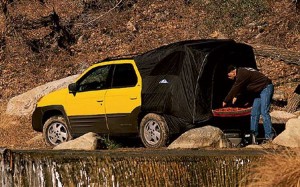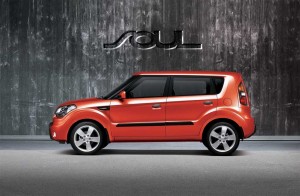
Maybe if you put a bag over its...tail? Was the Pontiac Aztek the ugliest vehicle ever made or a trendsetter ahead of its time?
I’m used to having people stare at me when I drive by. Well, not me, exactly, but the various cars I rotate through, on a regular basis. Call it the head-turn factor, if you will, for it’s one indication of how well a product stands out in today’s competitive and overcrowded automotive market.
Some vehicles grab your attention because they’re just plain beautiful, the Mercedes-Benz CLS, for example; others because they’re rare and exotic – a Bentley or a Lamborghini. Then there are the odd ducks that simply stand out, and these days there are a whole bunch of them coming to market.
There’s the Kia Soul, made famous by those hip little hamsters in a commercial that’s gone mega-hot on You Tube. Nissan’s weighed in with its own offering, the decidedly funky Cube. And, of course, we can’t ignore the xB, now in its second generation. The boxy crossover was the product that put Scion, Toyota’s youth-oriented brand-within-a-brand, on the map.
What do they all have in common? They’re basically all boxes on wheels, and more than a bit retro, with a hint of the classic, full-sized van in their DNA. That said, their designs are all a bit out of the norm, they’re definitely not minivans, nor are they SUVs. Each has a decidedly distinctive take on an otherwise fundamentally simple shape. The asymmetric Cube tries hard to be cute, Scion is L.A. street smart and Soul boasts hip-hop sensibilities, with its flashing interior lights.
 But above all, they’re designed to deliver maximum functionality – which is, after all, the thing that boxes, or vans, if you prefer, do best. So, it should be no surprise that the combination of form and function is connecting so well with today’s buyers, especially young ones also attracted to the reasonably low price tag of these three models.
But above all, they’re designed to deliver maximum functionality – which is, after all, the thing that boxes, or vans, if you prefer, do best. So, it should be no surprise that the combination of form and function is connecting so well with today’s buyers, especially young ones also attracted to the reasonably low price tag of these three models.
Then again, maybe it should be a surprise.
It wasn’t all that long ago that American buyers turned a big thumbs down on another quirkily-styled box-mobile that attempted to combine incredible functionality and flexibility — arguably a good bit more than the newer Soul, Cube and xB – and a bold styling statement.
I’m referring, of course, to the late and largely unlamented Pontiac Aztek.

Why does the Kia Soul connect with the American market when the Pontiac Aztek didn't? Bad design or cute hamsters?
The soon-to-depart General Motors division spent a number of years struggling to come up with a product that, in the words of former general manager John Middlebrook, would have “the versatility of a Swiss Army knife on wheels.” It rolled out a series of show cars before finally settling in the design that would become the Aztek.
A concept version first appeared in 1999, and what Pontiac dubbed its “Xtreme” styling and flexibility made it a hot ticket on the auto show circuit. But then came the production Aztek, which debuted during the 2001 model-year – it was launched in conjunction with the hit show, Survivor, and given the advertising tagline, “Quite possibly the most versatile vehicle on the planet.”
Versatile, no question, for it had an array of useful features, including a sliding cargo floor that made it easier to load and unload things. The center console could be used as a cooler, and there was a built-in air compressor that could inflate tires, air mattresses or floats. Options even allowed you to turn the Aztek into a camper. Those who focused on functionality often fell madly in love with Pontiac’s offering.
Everyone else?
Well, a lot had changed between concept and production vehicle. At the time the Aztek was being developed, General Motors’ troubled product development system was in the midst of turmoil. Beset by money woes, the manufacturing side of the company had come into power, dethroning the automaker’s legendary design department – which was blamed for rolling out some awful cars that, to make matters worse, cost too much to produce. Then manufacturing boss Don Hackworth and his team ordered sensuous curves straightened and rounded out deliberately hard edges. And to prove you don’t always need another chef in the kitchen, Pontiac planners insisted the production Aztek be saddled with the fluted rocker panels that were found on the rest of the division’s faltering line-up.
The final production design was, to be charitable, a camel, a two-humped one, at that. And not too many folks were very charitable, come to think of it. Time Magazine dubbed Aztek one of the worst cars of all time, while readers of Britain’s Daily Telegraph voted the crossover number one in a collection of “The 100 ugliest cars of all time.”
Despite several attempts to improve Aztek’s looks, the final vehicle rolled off the assembly line, in Ramos Arizpe, Mexico, in 2005. Sales never came close to meeting their numbers, with peak volume of only 27,793, during 2002, and barely 5,000 during the crossover’s final year.
Surprisingly, you still see them on the road, and those who still have them are likely to paraphrase actor and gun advocate Charlton Heston, declaring, “You can have my Aztek only when you pry the steering wheel from my cold, dead fingers.”
Do they know something we don’t? Is it possible that Pontiac was simply ahead of its time? If the Cube/Soul/xB had hit U.S. showrooms in 2001, what might Time or the Telegraph thought, back then?
I have to admit I’ve never been a fan of the production Aztek, and that’s putting it mildly. The concept vehicle is another story. Without the bizarre compromises created by a damaged GM system, Aztek might still have had its detractors, but it would have been a markedly more attractive vehicle, and just might have been the ur-box-mobile, the prototype for Cube, xB, Soul and others yet to come.
In terms of functionality and versatility, it actually is the progenitor of such new offerings.
Revisionist history, perhaps, but while the Aztek was clearly a retail market failure, history may show it’s had more influence than anyone might have imagined. Maybe it just needed a couple of hip-hop hamsters.

I appreciate the revisionist angle on this. Until now, I tried to hide that I was an original Aztek owner. Now I can just say I was ahead of my time. (right)
I didn’t and won’t have one, but when I saw one on the street a few days ago I said to myself it’s not as bad as it used to be.
Medusa class ugly, but this is an interesting angle from an informed and entertaining writer. Have a look at this as well:
http://www.thetruthaboutcars.com/in-praise-of-the-pontiac-aztek/
History says that the Edsel was also ahead of it’s time but based on the norms of the day it was ugly. I rented an Aztek once…it drove great but it was ugly. These new ugly rides probably drive great but…they are still ugly. Jeep seems to be skilled at creating a safe and versatile truck/car that drives great and looks tough (Compass excluded). Now we just need them to deliver 30mpg + fuel economy.